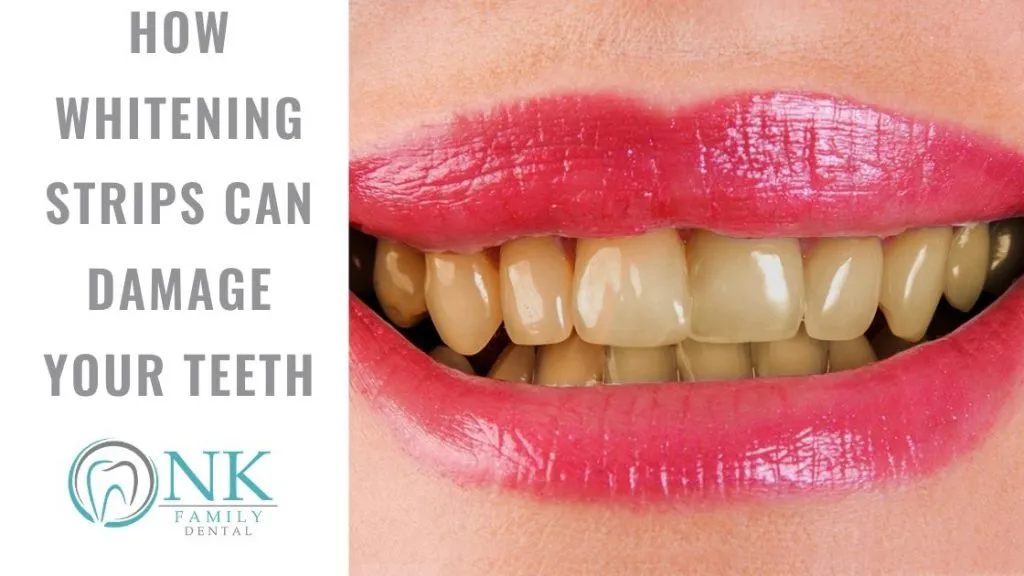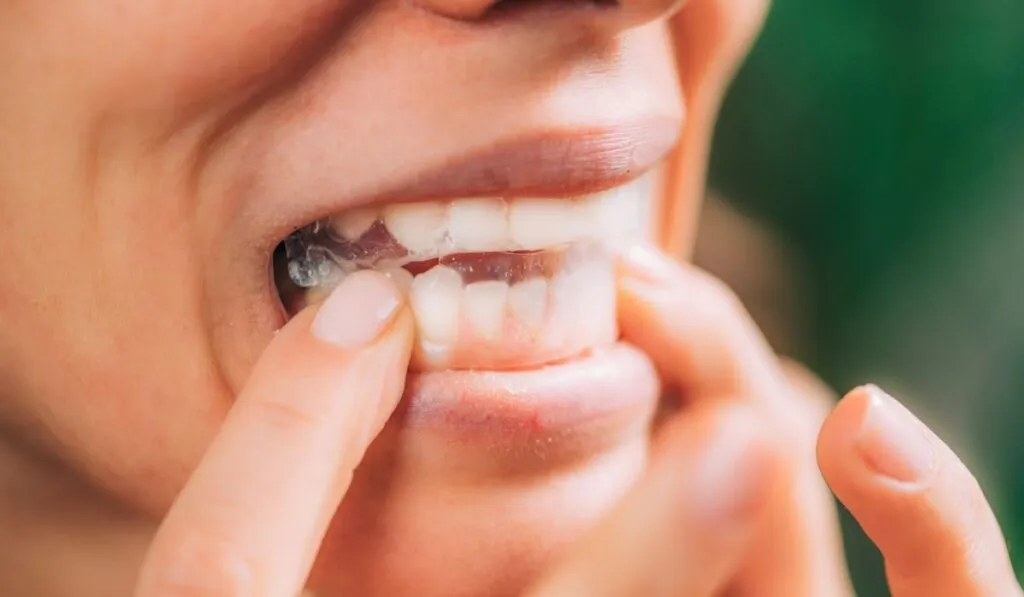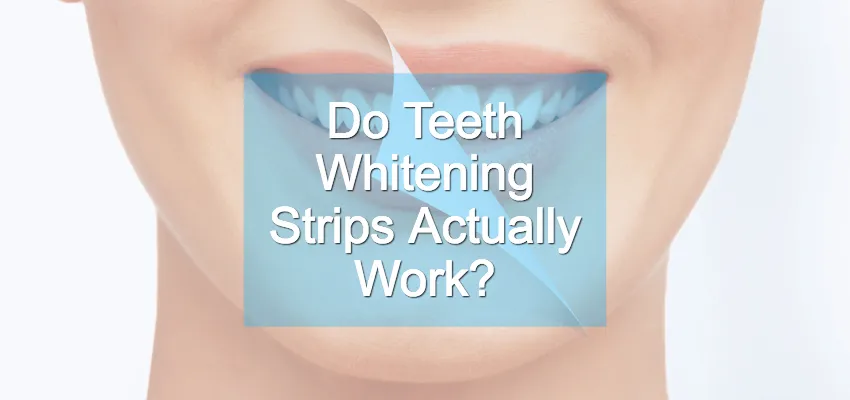What are Teeth Whitening Strips?
Teeth whitening strips have become a popular, convenient, and affordable method for enhancing the brightness of your smile. These thin, flexible strips are coated with a whitening agent, typically a form of peroxide, designed to adhere to the surface of your teeth. They are easily applied at home, making them a convenient alternative to professional teeth whitening treatments. These strips are designed to be used for a specific amount of time each day, as instructed by the product’s guidelines, offering a gradual and noticeable improvement in tooth shade. Their accessibility and ease of use have made them a staple in many people’s oral hygiene routines, contributing to their widespread appeal and usage. It is important to understand the ingredients, how they work, and the potential risks before you begin using teeth whitening strips.
How Do Teeth Whitening Strips Work?
The primary mechanism behind teeth whitening strips involves the chemical reaction of the whitening agent with the discolored molecules present in the tooth enamel. The active ingredients, such as hydrogen peroxide or carbamide peroxide, penetrate the enamel and break down these stain molecules. This process effectively lightens the overall shade of the teeth, resulting in a brighter and more appealing smile. The strips’ design ensures close contact between the whitening agent and the tooth surface, maximizing the effectiveness of the process. The gradual release of the whitening agent over the specified time period allows for a controlled and generally safe whitening experience, provided that the instructions are followed carefully. The effectiveness, however, can depend on the type and concentration of the whitening agent, as well as the duration of the treatment and the nature of the staining.
Understanding the Active Ingredients

The efficacy of teeth whitening strips is largely dependent on the active ingredients they contain. These ingredients are responsible for the chemical reaction that breaks down the stains on your teeth. Understanding these components and their functions can help users make informed decisions about product selection and usage. The most common active ingredients are hydrogen peroxide and carbamide peroxide. Each ingredient has its own characteristics, which influence its effectiveness and potential side effects. Knowing the differences helps you assess which product suits your specific needs and sensitivity levels. It’s also vital to know that the concentration of these ingredients will vary from product to product, with higher concentrations typically leading to faster results but also increasing the potential for adverse effects.
Common Whitening Strip Ingredients
The most commonly found active ingredients in teeth whitening strips are hydrogen peroxide and carbamide peroxide. Both of these compounds are oxidizing agents, meaning they release oxygen molecules. These oxygen molecules then interact with the stains on the tooth enamel, breaking them down and leading to a whiter appearance. The concentration of these ingredients is critical. A higher concentration may lead to faster results but also increases the risk of side effects. The type and concentration of the active ingredient are key factors influencing the overall effectiveness and safety of the teeth whitening strips. Always refer to the product’s instructions for specific guidance on the concentration and how it affects the usage.
Hydrogen Peroxide
Hydrogen peroxide is a powerful oxidizing agent, and it is frequently used in teeth whitening products due to its effectiveness in breaking down stain molecules. It is often used in higher concentrations in professional whitening treatments administered by dentists. In teeth whitening strips, the concentration of hydrogen peroxide can vary, and it directly affects the speed and intensity of the whitening effect. It’s important to note that higher concentrations can increase the risk of tooth sensitivity and gum irritation. Products containing hydrogen peroxide often provide noticeable results relatively quickly, making it a popular choice for those seeking immediate improvement. However, due to its potency, it’s essential to follow the manufacturer’s instructions precisely to avoid potential side effects and ensure a safe and effective whitening experience.
Carbamide Peroxide

Carbamide peroxide is another common ingredient used in teeth whitening strips. It is a compound that breaks down into hydrogen peroxide and urea. The urea component acts as a moisturizing agent, which can help reduce tooth sensitivity. Carbamide peroxide is generally considered a more gentle option compared to higher concentrations of hydrogen peroxide. This makes it a suitable choice for those with sensitive teeth. The slower release of hydrogen peroxide from carbamide peroxide often results in a more gradual whitening effect, which can be beneficial in minimizing potential side effects. The concentration of carbamide peroxide also affects the whitening power, so it is important to carefully review the product’s instructions for the most effective and safe usage.
The Risks of Using Teeth Whitening Strips
While teeth whitening strips are generally safe when used as directed, there are potential risks and side effects that users should be aware of. Understanding these risks can help individuals make informed decisions about their oral care routine and take appropriate precautions. Side effects can vary based on individual sensitivity, the concentration of the active ingredients, and the duration of the treatment. The most common risks include tooth sensitivity, gum irritation, and, in rare cases, enamel damage. Consulting with a dentist before starting any whitening treatment is always recommended, especially for individuals with pre-existing dental conditions. Careful adherence to the product instructions is crucial for minimizing these risks and ensuring a safe and effective whitening experience.
Sensitivity and Irritation
Tooth sensitivity is one of the most common side effects associated with teeth whitening strips. This occurs when the whitening agent penetrates the enamel and irritates the nerves inside the teeth. This sensitivity can manifest as a sharp, shooting pain or discomfort, particularly when consuming hot or cold foods and drinks. The severity of the sensitivity varies among individuals and can be influenced by factors such as the concentration of the whitening agent, the duration of use, and the individual’s existing dental health. Gum irritation is another common side effect. The peroxide in the strips can come into contact with the gums, causing redness, swelling, and sometimes, a burning sensation. Both tooth sensitivity and gum irritation typically subside shortly after discontinuing the use of the strips or reducing the frequency of applications.
Gum Irritation

Gum irritation is a common side effect of using teeth whitening strips. The active whitening ingredients, such as hydrogen peroxide, can come into contact with the soft tissues of the gums, leading to inflammation, redness, and, in some cases, a burning sensation. The sensitivity of the gums to these ingredients can vary depending on the individual and the concentration of the whitening agent in the strips. Improper application, such as overlapping the strips onto the gums, or prolonged exposure can exacerbate this irritation. The effects of the peroxide on the gums can be uncomfortable and may lead to temporary cosmetic changes. It is crucial to avoid contact between the strips and the gums and to follow the instructions carefully to minimize the risk of gum irritation. In case of persistent irritation, it is recommended to consult with a dentist.
Enamel Damage
Enamel damage is a less common but more serious risk associated with the misuse of teeth whitening strips. While enamel is highly resistant to wear and tear, excessive or improper use of whitening products can potentially erode the enamel over time. This can make the teeth more susceptible to cavities, sensitivity, and discoloration. Damage to the enamel can be more likely if the strips are used too frequently, for extended periods, or with high concentrations of the whitening agent. The risk is also higher for individuals with pre-existing dental conditions. Following the product instructions carefully, limiting application time, and consulting a dentist are essential steps to prevent enamel damage and protect the overall health of the teeth.
What Happens if You Fall Asleep with Strips?
Falling asleep while using teeth whitening strips is not recommended and can potentially lead to a range of adverse effects. The primary concern is the prolonged exposure of your teeth and gums to the whitening agent, which can significantly increase the risk of sensitivity, irritation, and, in some cases, more serious damage. The longer the whitening agent remains in contact with the teeth, the greater the likelihood of these side effects. This can result in heightened sensitivity to hot and cold temperatures, as well as inflammation and discomfort in the gums. The potential for over-whitening is also a significant concern. This can lead to an uneven or unnatural appearance of the teeth and can be difficult to correct. It is crucial to remove the strips immediately if you realize you have fallen asleep and take the necessary corrective actions.
Potential for Over-Whitening

Over-whitening is a potential consequence of using teeth whitening strips for an extended period or beyond the recommended time. This happens when the enamel becomes excessively bleached, leading to an uneven or unnatural appearance. Over-whitening can make your teeth appear translucent or chalky, and it can also create an overly bright contrast with the surrounding tissues, such as the gums. The effects of over-whitening can be difficult to reverse and may require professional dental treatments to correct the color and restore the natural appearance of the teeth. The risk of over-whitening is higher when using high-concentration whitening products or when the strips are left on for extended periods, such as when falling asleep with them. The best approach is to follow the instructions carefully and avoid exceeding the recommended usage duration.
Increased Sensitivity
Increased sensitivity is a likely outcome if you fall asleep with teeth whitening strips. The prolonged contact of the whitening agent with your teeth allows it to penetrate the enamel more deeply, irritating the nerves inside the teeth. This heightened sensitivity can make your teeth feel more susceptible to hot and cold temperatures, and it can cause sharp, shooting pains or discomfort. It is advisable to remove the strips and rinse your mouth thoroughly with water. You can also use a toothpaste designed for sensitive teeth to alleviate the discomfort. If the sensitivity persists or worsens, it is crucial to consult your dentist, who can provide further guidance and treatment. Avoiding the triggers, such as extremely hot or cold foods, can also help manage the sensitivity while your teeth recover.
Corrective Actions if You Fall Asleep with Strips?
If you fall asleep with teeth whitening strips, it’s important to take immediate and appropriate corrective actions to minimize potential side effects. The first step is to remove the strips as soon as you wake up. The longer the whitening agent remains in contact with your teeth and gums, the greater the chance of increased sensitivity, irritation, and other complications. After removing the strips, thoroughly rinse your mouth to remove any residual whitening agent. Following these steps and, if necessary, consulting a dentist will help reduce potential harm and help you maintain your oral health. Prompt action is vital, as it can significantly mitigate the adverse effects of prolonged exposure to the whitening strips.
Rinse Your Mouth Thoroughly

After waking up with teeth whitening strips still applied, the first and most important action is to rinse your mouth thoroughly with water. This step is crucial because it helps to remove any remaining whitening agent and reduces its contact with your teeth and gums. Rinsing with water dilutes and washes away the active ingredients, such as hydrogen peroxide or carbamide peroxide, which can cause sensitivity and irritation if left in contact with the oral tissues for an extended time. Be sure to rinse every area of your mouth, including the gums and the tongue, to remove any residual chemicals. Following a thorough rinsing, you may also want to brush your teeth gently with a soft-bristled toothbrush and a toothpaste designed for sensitive teeth to further reduce any irritation.
Assess for Sensitivity
After rinsing your mouth thoroughly, the next step is to assess your teeth for sensitivity. Pay close attention to any discomfort or pain when consuming hot, cold, or sugary foods and drinks. Sensitivity may manifest as a sharp, shooting pain or a general feeling of discomfort. Take note of any signs of gum irritation, such as redness, swelling, or a burning sensation. If you experience significant sensitivity or irritation, you can use toothpaste designed for sensitive teeth. If the sensitivity persists or worsens, consult your dentist for further evaluation and advice. Recognizing the signs of sensitivity early allows you to take appropriate measures to alleviate discomfort and protect your oral health.
Contact Your Dentist
If you experience significant sensitivity, irritation, or any other unusual symptoms after falling asleep with teeth whitening strips, the next step is to contact your dentist. Your dentist can assess the extent of any damage or side effects and provide guidance on how to treat the affected areas. They may recommend using specialized toothpaste, applying fluoride treatments, or adjusting your oral hygiene routine to alleviate discomfort and protect your teeth. It is always best to consult with a dental professional whenever you have concerns about your oral health, especially after experiencing an adverse reaction to a teeth whitening product. Your dentist has the expertise and tools to offer appropriate treatment and advice. Seeking professional dental care helps to avoid any long-term complications and ensures your oral health.
How to Use Teeth Whitening Strips Safely

To ensure the safe and effective use of teeth whitening strips, it is essential to follow the instructions provided by the manufacturer meticulously. Safe usage involves adhering to the recommended application time, frequency, and any other guidelines. Proper application helps to minimize the risks of sensitivity, irritation, and enamel damage. It is also recommended to avoid using the strips if you have underlying oral health conditions without first consulting with a dentist. Regular check-ups and professional advice can help to ensure that you are using teeth whitening strips correctly and safely, leading to optimal results. Always store the strips in a cool, dry place and out of the reach of children.
Follow Instructions Carefully
The most critical factor in using teeth whitening strips safely is to follow the product instructions precisely. These instructions are developed based on the specific formula and concentration of the whitening agent in the strips. The manufacturer provides detailed guidelines on how long to apply the strips, how frequently to use them, and any necessary precautions to take. Failure to adhere to these instructions can lead to a higher risk of side effects, such as sensitivity and irritation. Carefully read and understand all the instructions before starting the treatment, and be sure to apply the strips in the correct manner, avoiding contact with the gums. If you have any questions or uncertainties, consult a dental professional or the product manufacturer for clarity. Always remember that consistent and correct usage is paramount to achieving safe and effective results.
Limit Application Time
Limiting the application time of teeth whitening strips is crucial to minimize the risk of potential side effects and to ensure the safety of your teeth and gums. Overexposure to the whitening agent can lead to increased sensitivity, gum irritation, and potentially enamel damage. The duration of application is specified by the manufacturer. Exceeding this duration is not recommended. Keep track of the time and set a timer if necessary to ensure you do not leave the strips on for longer than instructed. When using teeth whitening strips, it’s important to prioritize safety and adhere to the recommended guidelines for application time. This helps in getting the desired results while maintaining optimal oral health.
Consider Sensitivity

Prioritizing your tooth sensitivity before and during teeth whitening strip use is vital. Before starting any teeth whitening treatment, consider your existing sensitivity level. If you have sensitive teeth, you might want to consult your dentist to explore other options. During the process, be mindful of any changes in sensitivity. If you experience increased discomfort or pain, discontinue use immediately and reassess your situation. Using toothpaste designed for sensitive teeth can provide relief from sensitivity. If sensitivity persists, seek professional advice from your dentist. Being attentive to your teeth’s sensitivity helps in enjoying a brighter smile safely.
Alternatives to Teeth Whitening Strips
If you are concerned about the potential risks associated with teeth whitening strips or if you have sensitive teeth, several alternative options are available. These options offer a range of approaches to teeth whitening, each with its own benefits and considerations. From professional treatments administered by a dentist to over-the-counter products, you have multiple pathways to achieve a brighter smile. Understanding these alternatives allows you to choose the option that best suits your individual needs and preferences while minimizing potential side effects. Remember, consulting with your dentist is always recommended. They can provide personalized advice based on your oral health and goals.
Professional Whitening
Professional teeth whitening, performed by a dentist, is a highly effective and controlled method for brightening your smile. Dentists use stronger concentrations of whitening agents, often hydrogen peroxide, which can produce more dramatic results in a shorter amount of time compared to at-home treatments. The procedure is usually performed in the dental office under controlled conditions, which minimizes the risk of side effects. Your dentist can monitor your teeth and gums throughout the procedure, which ensures your safety. Professional whitening often includes pre-treatment and post-treatment care to reduce sensitivity and maintain the results. If you desire significant results and want to ensure a safe and controlled experience, professional whitening is an excellent choice.
Whitening Toothpaste
Whitening toothpaste is a convenient and accessible option for enhancing the brightness of your teeth. These toothpastes contain mild abrasives and chemicals that help remove surface stains, such as those caused by coffee, tea, or tobacco. While whitening toothpastes are generally less effective than professional treatments or teeth whitening strips, they can be a good option for maintaining your teeth’s brightness or for those with minor staining. Some whitening toothpastes also contain ingredients that help prevent new stains from forming. Using whitening toothpaste regularly as part of your daily oral hygiene routine can contribute to a brighter smile over time. Remember that consistent use is key, and you will see the results gradually.
Maintaining a Bright Smile
Maintaining a bright and healthy smile involves a combination of good oral hygiene practices and lifestyle choices. Regular brushing and flossing are essential to remove plaque and prevent the build-up of stains. Avoiding or limiting the consumption of stain-causing foods and drinks, such as coffee, tea, and red wine, can also help preserve your teeth’s brightness. Visiting your dentist for regular check-ups and cleanings is also crucial, as they can remove surface stains and identify any potential issues before they worsen. Maintaining a bright smile is an ongoing process, and it requires a commitment to consistent care. By making healthy choices and following a consistent oral hygiene routine, you can enjoy a confident and radiant smile for years to come.
